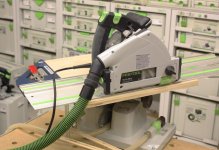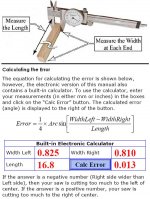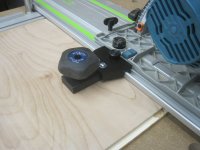- Joined
- Jan 22, 2007
- Messages
- 1,486
A couple of days ago Hans stopped by to chat over lunch. Same place we sat some time ago when he first proposed the idea for his GRS-16 guide rail square. What came out of that previous meeting, besides a full belly, was the concept whereby the square would never need adjustment nor calibration. So I was a little surprised when Hans told me the other day that a woodworker claimed that the GRS-16 failed on a 4-cut/5-cut calibration.
I said that wasn't possible. The GRS is machined at the same machine shop that I've been using for the past 6 years. Their default tolerances are too low, and the design leaves no source for error. So I agreed to put the GRS-16 through a 5-cut calibration. (Yes, for this test, I even did the 5th cut.)
I placed a piece of 18-inch plywood on Vacsys so I could spin it without undue handling. I mounted the GRS-16 to my 32-inch guide rail, and slid a Festool Quick Clamp down the rail to ensure the guide rail didn't move during each cut. I made sure the guide rail gib cams were properly adjusted on my TS55, with the standard blade.
[attachimg=1]
The resulting offcut was 16-3/4" long, and it was pretty obvious that it was parallel for that long of a cut. So I brought it up to the office where I keep my most accurate caliper to measure. I got 0.825 width at one end, and 0.810 width at the other. That's just 0.015" per 16 inches, or 0.001 per inch. Pretty darned good. So I plugged the numbers into the angle calculator in my Kapex manual, and came up with an angular error of only 0.013 degrees.
That small of an error is what you'd expect if you had a piece of sawdust trapped between the square and the workpiece. More importantly, it's down in the range of machine shop tolerances, except we're in a wood shop. For a hand-held saw, with all of the unknown variables that can come into play with accuracy...that's a pretty astounding result.
[attachimg=2]
So how could someone come up with a bad result? Well, down at this level of precision, even the slightest of variances can affect the result. This is a calibration, so you're not trying to make a routine cut. You want your cuts to be as absolutely precise as possible, and you want to remove as much human error as possible.
Two things come to mind that will result in erroneous results: Plunging the saw down into the beginning of the cut, or not having the blade inside wood on both sides of the blade.
If you plunge down into the wood, as opposed to plunging before the saw reaches the wood, the beginning of your cut may likely have a small amount of snipe that normally wouldn’t be detected, but is detectable in a calibration.
If you don’t have the blade completely buried in wood on both sides of the blade, the blade can drift. If you're only shaving the edge where only one side of the blade is actually cutting, then the ATB (alternate top bevel) teeth of the blade will cause the blade to deflect unevenly.
I said that wasn't possible. The GRS is machined at the same machine shop that I've been using for the past 6 years. Their default tolerances are too low, and the design leaves no source for error. So I agreed to put the GRS-16 through a 5-cut calibration. (Yes, for this test, I even did the 5th cut.)
I placed a piece of 18-inch plywood on Vacsys so I could spin it without undue handling. I mounted the GRS-16 to my 32-inch guide rail, and slid a Festool Quick Clamp down the rail to ensure the guide rail didn't move during each cut. I made sure the guide rail gib cams were properly adjusted on my TS55, with the standard blade.
[attachimg=1]
The resulting offcut was 16-3/4" long, and it was pretty obvious that it was parallel for that long of a cut. So I brought it up to the office where I keep my most accurate caliper to measure. I got 0.825 width at one end, and 0.810 width at the other. That's just 0.015" per 16 inches, or 0.001 per inch. Pretty darned good. So I plugged the numbers into the angle calculator in my Kapex manual, and came up with an angular error of only 0.013 degrees.
That small of an error is what you'd expect if you had a piece of sawdust trapped between the square and the workpiece. More importantly, it's down in the range of machine shop tolerances, except we're in a wood shop. For a hand-held saw, with all of the unknown variables that can come into play with accuracy...that's a pretty astounding result.
[attachimg=2]
So how could someone come up with a bad result? Well, down at this level of precision, even the slightest of variances can affect the result. This is a calibration, so you're not trying to make a routine cut. You want your cuts to be as absolutely precise as possible, and you want to remove as much human error as possible.
Two things come to mind that will result in erroneous results: Plunging the saw down into the beginning of the cut, or not having the blade inside wood on both sides of the blade.
If you plunge down into the wood, as opposed to plunging before the saw reaches the wood, the beginning of your cut may likely have a small amount of snipe that normally wouldn’t be detected, but is detectable in a calibration.
If you don’t have the blade completely buried in wood on both sides of the blade, the blade can drift. If you're only shaving the edge where only one side of the blade is actually cutting, then the ATB (alternate top bevel) teeth of the blade will cause the blade to deflect unevenly.



